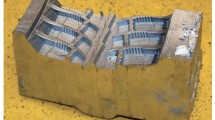Conclusions
-
1.
The internal stresses are most effectively reduced in alloy ML19 (about 10 times) by high-temperature annealing of the castings at 420–450° (furnace cooling or air cooling).
-
2.
High-temperature annealing of quenched and aged samples lowers the ultimate strength and yield strength of the alloy at room temperature by 20–25% and doubles the relative elongation.
-
3.
Preliminary high-temperature annealing has no effect on the mechanical properties of the alloy after quenching (heating at 535° for 4–8 h, cooling in compressed air) or aging (at 205° for 12 h, cooling in air), and thus can be recommended to remove internal stresses before welding or before straightening.
Similar content being viewed by others
Additional information
All-Union Institute of Aviation Materials. Translated from Metallovedenie i Termicheskaya Obrabotka Metallov, No. 3, pp. 70–71, March, 1977.
Rights and permissions
About this article
Cite this article
Tikhova, N.M., Blokhina, V.A. & Antipova, A.P. Effect of heat treatment on dimensional stability of castings and mechanical properties of alloy ML19. Met Sci Heat Treat 19, 239–240 (1977). https://doi.org/10.1007/BF01167014
Issue Date:
DOI: https://doi.org/10.1007/BF01167014




